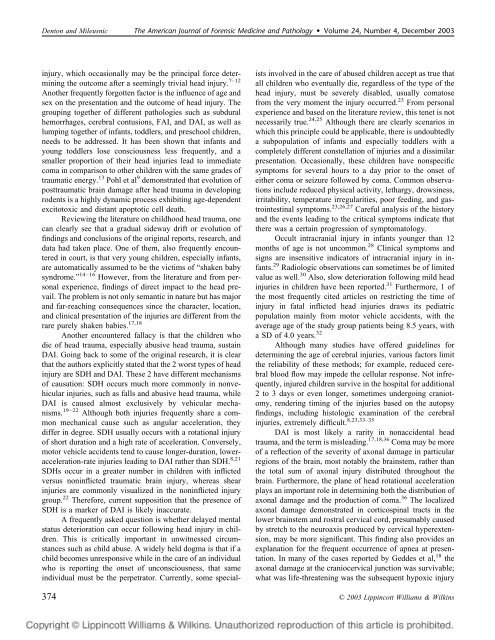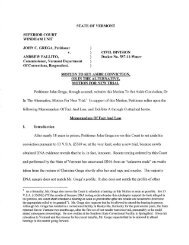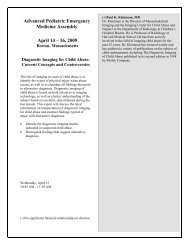Delayed Sudden Death in an Infant Following an Accidental Fall
Delayed Sudden Death in an Infant Following an Accidental Fall
Delayed Sudden Death in an Infant Following an Accidental Fall
Create successful ePaper yourself
Turn your PDF publications into a flip-book with our unique Google optimized e-Paper software.
Denton <strong>an</strong>d Mileusnic The Americ<strong>an</strong> Journal of Forensic Medic<strong>in</strong>e <strong>an</strong>d Pathology • Volume 24, Number 4, December 2003<br />
<strong>in</strong>jury, which occasionally may be the pr<strong>in</strong>cipal force determ<strong>in</strong><strong>in</strong>g<br />
the outcome after a seem<strong>in</strong>gly trivial head <strong>in</strong>jury. 7–12<br />
Another frequently forgotten factor is the <strong>in</strong>fluence of age <strong>an</strong>d<br />
sex on the presentation <strong>an</strong>d the outcome of head <strong>in</strong>jury. The<br />
group<strong>in</strong>g together of different pathologies such as subdural<br />
hemorrhages, cerebral contusions, FAI, <strong>an</strong>d DAI, as well as<br />
lump<strong>in</strong>g together of <strong>in</strong>f<strong>an</strong>ts, toddlers, <strong>an</strong>d preschool children,<br />
needs to be addressed. It has been shown that <strong>in</strong>f<strong>an</strong>ts <strong>an</strong>d<br />
young toddlers lose consciousness less frequently, <strong>an</strong>d a<br />
smaller proportion of their head <strong>in</strong>juries lead to immediate<br />
coma <strong>in</strong> comparison to other children with the same grades of<br />
traumatic energy. 13 Pohl et al 9 demonstrated that evolution of<br />
posttraumatic bra<strong>in</strong> damage after head trauma <strong>in</strong> develop<strong>in</strong>g<br />
rodents is a highly dynamic process exhibit<strong>in</strong>g age-dependent<br />
excitotoxic <strong>an</strong>d dist<strong>an</strong>t apoptotic cell death.<br />
Review<strong>in</strong>g the literature on childhood head trauma, one<br />
c<strong>an</strong> clearly see that a gradual sideway drift or evolution of<br />
f<strong>in</strong>d<strong>in</strong>gs <strong>an</strong>d conclusions of the orig<strong>in</strong>al reports, research, <strong>an</strong>d<br />
data had taken place. One of them, also frequently encountered<br />
<strong>in</strong> court, is that very young children, especially <strong>in</strong>f<strong>an</strong>ts,<br />
are automatically assumed to be the victims of “shaken baby<br />
syndrome.” 14–16 However, from the literature <strong>an</strong>d from personal<br />
experience, f<strong>in</strong>d<strong>in</strong>gs of direct impact to the head prevail.<br />
The problem is not only sem<strong>an</strong>tic <strong>in</strong> nature but has major<br />
<strong>an</strong>d far-reach<strong>in</strong>g consequences s<strong>in</strong>ce the character, location,<br />
<strong>an</strong>d cl<strong>in</strong>ical presentation of the <strong>in</strong>juries are different from the<br />
rare purely shaken babies. 17,18<br />
Another encountered fallacy is that the children who<br />
die of head trauma, especially abusive head trauma, susta<strong>in</strong><br />
DAI. Go<strong>in</strong>g back to some of the orig<strong>in</strong>al research, it is clear<br />
that the authors explicitly stated that the 2 worst types of head<br />
<strong>in</strong>jury are SDH <strong>an</strong>d DAI. These 2 have different mech<strong>an</strong>isms<br />
of causation: SDH occurs much more commonly <strong>in</strong> nonvehicular<br />
<strong>in</strong>juries, such as falls <strong>an</strong>d abusive head trauma, while<br />
DAI is caused almost exclusively by vehicular mech<strong>an</strong>isms.<br />
19–22 Although both <strong>in</strong>juries frequently share a common<br />
mech<strong>an</strong>ical cause such as <strong>an</strong>gular acceleration, they<br />
differ <strong>in</strong> degree. SDH usually occurs with a rotational <strong>in</strong>jury<br />
of short duration <strong>an</strong>d a high rate of acceleration. Conversely,<br />
motor vehicle accidents tend to cause longer-duration, loweracceleration-rate<br />
<strong>in</strong>juries lead<strong>in</strong>g to DAI rather th<strong>an</strong> SDH. 8,21<br />
SDHs occur <strong>in</strong> a greater number <strong>in</strong> children with <strong>in</strong>flicted<br />
versus non<strong>in</strong>flicted traumatic bra<strong>in</strong> <strong>in</strong>jury, whereas shear<br />
<strong>in</strong>juries are commonly visualized <strong>in</strong> the non<strong>in</strong>flicted <strong>in</strong>jury<br />
group. 22 Therefore, current supposition that the presence of<br />
SDH is a marker of DAI is likely <strong>in</strong>accurate.<br />
A frequently asked question is whether delayed mental<br />
status deterioration c<strong>an</strong> occur follow<strong>in</strong>g head <strong>in</strong>jury <strong>in</strong> children.<br />
This is critically import<strong>an</strong>t <strong>in</strong> unwitnessed circumst<strong>an</strong>ces<br />
such as child abuse. A widely held dogma is that if a<br />
child becomes unresponsive while <strong>in</strong> the care of <strong>an</strong> <strong>in</strong>dividual<br />
who is report<strong>in</strong>g the onset of unconsciousness, that same<br />
<strong>in</strong>dividual must be the perpetrator. Currently, some special-<br />
374<br />
ists <strong>in</strong>volved <strong>in</strong> the care of abused children accept as true that<br />
all children who eventually die, regardless of the type of the<br />
head <strong>in</strong>jury, must be severely disabled, usually comatose<br />
from the very moment the <strong>in</strong>jury occurred. 23 From personal<br />
experience <strong>an</strong>d based on the literature review, this tenet is not<br />
necessarily true. 24,25 Although there are clearly scenarios <strong>in</strong><br />
which this pr<strong>in</strong>ciple could be applicable, there is undoubtedly<br />
a subpopulation of <strong>in</strong>f<strong>an</strong>ts <strong>an</strong>d especially toddlers with a<br />
completely different constellation of <strong>in</strong>juries <strong>an</strong>d a dissimilar<br />
presentation. Occasionally, these children have nonspecific<br />
symptoms for several hours to a day prior to the onset of<br />
either coma or seizure followed by coma. Common observations<br />
<strong>in</strong>clude reduced physical activity, lethargy, drows<strong>in</strong>ess,<br />
irritability, temperature irregularities, poor feed<strong>in</strong>g, <strong>an</strong>d gastro<strong>in</strong>test<strong>in</strong>al<br />
symptoms. 23,26,27 Careful <strong>an</strong>alysis of the history<br />
<strong>an</strong>d the events lead<strong>in</strong>g to the critical symptoms <strong>in</strong>dicate that<br />
there was a certa<strong>in</strong> progression of symptomatology.<br />
Occult <strong>in</strong>tracr<strong>an</strong>ial <strong>in</strong>jury <strong>in</strong> <strong>in</strong>f<strong>an</strong>ts younger th<strong>an</strong> 12<br />
months of age is not uncommon. 28 Cl<strong>in</strong>ical symptoms <strong>an</strong>d<br />
signs are <strong>in</strong>sensitive <strong>in</strong>dicators of <strong>in</strong>tracr<strong>an</strong>ial <strong>in</strong>jury <strong>in</strong> <strong>in</strong>f<strong>an</strong>ts.<br />
29 Radiologic observations c<strong>an</strong> sometimes be of limited<br />
value as well. 30 Also, slow deterioration follow<strong>in</strong>g mild head<br />
<strong>in</strong>juries <strong>in</strong> children have been reported. 31 Furthermore, 1 of<br />
the most frequently cited articles on restrict<strong>in</strong>g the time of<br />
<strong>in</strong>jury <strong>in</strong> fatal <strong>in</strong>flicted head <strong>in</strong>juries draws its pediatric<br />
population ma<strong>in</strong>ly from motor vehicle accidents, with the<br />
average age of the study grouppatients be<strong>in</strong>g 8.5 years, with<br />
a SD of 4.0 years. 32<br />
Although m<strong>an</strong>y studies have offered guidel<strong>in</strong>es for<br />
determ<strong>in</strong><strong>in</strong>g the age of cerebral <strong>in</strong>juries, various factors limit<br />
the reliability of these methods; for example, reduced cerebral<br />
blood flow may impede the cellular response. Not <strong>in</strong>frequently,<br />
<strong>in</strong>jured children survive <strong>in</strong> the hospital for additional<br />
2 to 3 days or even longer, sometimes undergo<strong>in</strong>g cr<strong>an</strong>iotomy,<br />
render<strong>in</strong>g tim<strong>in</strong>g of the <strong>in</strong>juries based on the autopsy<br />
f<strong>in</strong>d<strong>in</strong>gs, <strong>in</strong>clud<strong>in</strong>g histologic exam<strong>in</strong>ation of the cerebral<br />
<strong>in</strong>juries, extremely difficult. 8,23,33–35<br />
DAI is most likely a rarity <strong>in</strong> nonaccidental head<br />
trauma, <strong>an</strong>d the term is mislead<strong>in</strong>g. 17,18,36 Coma may be more<br />
of a reflection of the severity of axonal damage <strong>in</strong> particular<br />
regions of the bra<strong>in</strong>, most notably the bra<strong>in</strong>stem, rather th<strong>an</strong><br />
the total sum of axonal <strong>in</strong>jury distributed throughout the<br />
bra<strong>in</strong>. Furthermore, the pl<strong>an</strong>e of head rotational acceleration<br />
plays <strong>an</strong> import<strong>an</strong>t role <strong>in</strong> determ<strong>in</strong><strong>in</strong>g both the distribution of<br />
axonal damage <strong>an</strong>d the production of coma. 36 The localized<br />
axonal damage demonstrated <strong>in</strong> corticosp<strong>in</strong>al tracts <strong>in</strong> the<br />
lower bra<strong>in</strong>stem <strong>an</strong>d rostral cervical cord, presumably caused<br />
by stretch to the neuroaxis produced by cervical hyperextension,<br />
may be more signific<strong>an</strong>t. This f<strong>in</strong>d<strong>in</strong>g also provides <strong>an</strong><br />
expl<strong>an</strong>ation for the frequent occurrence of apnea at presentation.<br />
In m<strong>an</strong>y of the cases reported by Geddes et al, 18 the<br />
axonal damage at the cr<strong>an</strong>iocervical junction was survivable;<br />
what was life-threaten<strong>in</strong>g was the subsequent hypoxic <strong>in</strong>jury<br />
© 2003 Lipp<strong>in</strong>cott Williams & Wilk<strong>in</strong>s




